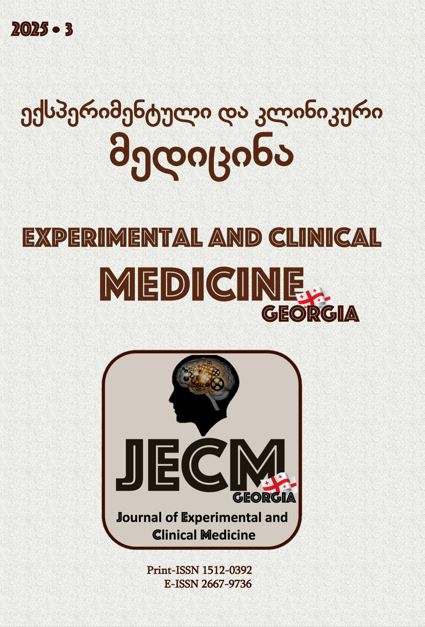ATOPIC DERMATITIS IN THE ERA OF INNOVATIONS (Reviewing and exploring modern research and literature on treatment of atopic dermatitis with microbial transplantation)
DOI:
https://doi.org/10.52340/jecm.2025.03.02Keywords:
atopic dermatitis, innovations, literature reviewAbstract
Atopic dermatitis is a chronic inflammatory skin disease with growing global prevalence, affecting both children and adults. It is characterized by immune system dysregulation, skin barrier dysfunction, and a complex interplay between genetic and environmental factors. Conventional treatments, such as topical corticosteroids, calcineurin inhibitors, and biologics, focus on symptom management but do not agree the underlying causes. This has led to an increasing interest in alternative approaches, including microbiome-targeted therapies. Fecal microbiota transplantation (FMT) has emerged as a novel therapeutic strategy for atopic dermatitis by restoring gut microbiota diversity and modulating immune responses through the gut-skin-axis. Recent studies suggest that dysbiosis plays a crucial role in atopic dermatitis pathogenesis, contributing to systemic inflammation and disease severity. FMT has shown potential in improving atopic dermatitis symptoms by rebalancing gut microbiota, enhancing regulatory immune pathways, and reducing inflammatory cytokine production. Clinical trials have demonstrated promising efficacy, but challenges remain regarding standardization, donor selection, and long-term safety.
This review explores the epidemiology of atopic dermatitis, the immunological mechanisms of FMT, and its potential as a cost-effective treatment. Given its affordability and potential long-term benefits, FMT could provide an accessible alternative to expensive biologic therapies. With further research and regulatory advancements, integrating FMT into dermatological practice could offer a transformative solution for atopic dermatitis management, improving patient outcomes and reducing the burden on healthcare systems.
Downloads
References
Laughter MR, Maymone MBC, Mashayekhi S, et al. The global burden of atopic dermatitis: lessons from the Global Burden of Disease Study 1990–2017*. British Journal of Dermatology. 2021;184(2):304-309.
Choragudi S, Yosipovitch G. Trends in the Prevalence of Eczema Among US Children by Age, Sex, Race, and Ethnicity From 1997 to 2018. JAMA Dermatol. 2023;159(4):454-456.
Chiesa Fuxench ZC, Block JK, Boguniewicz M, et al. Atopic Dermatitis in America Study: A Cross-Sectional Study Examining the Prevalence and Disease Burden of Atopic Dermatitis in the US Adult Population. J Invest Dermatol. 2019;139(3):583-590.
Chung J, Simpson EL. The socioeconomics of atopic dermatitis. Ann Allergy Asthma Immunol. 2019;122(4):360-366.
Croce EA, Levy ML, Adamson AS, Matsui EC. Reframing racial and ethnic disparities in atopic dermatitis in Black and Latinx populations. J Allergy Clin Immunol. 2021;148(5):1104-1111.
Abuabara K, Yu AM, Okhovat JP, Allen IE, Langan SM. The prevalence of atopic dermatitis beyond childhood: A systematic review and meta-analysis of longitudinal studies. Allergy. 2018;73(3):696-704.
Lee HH, Patel KR, Singam V, Rastogi S, Silverberg JI. A systematic review and meta-analysis of the prevalence and phenotype of adult-onset atopic dermatitis. J Am Acad Dermatol. 2019;80(6):1526-1532.e7.
Schuler CF 4th, Tsoi LC, Billi AC, Harms PW, Weidinger S, Gudjonsson JE. Genetic and Immunological Pathogenesis of Atopic Dermatitis. J Invest Dermatol. 2024;144(5):954-968.
Choragudi S, Yosipovitch G. Trends in the Prevalence of Eczema Among US Children by Age, Sex, Race, and Ethnicity From 1997 to 2018. JAMA Dermatol. 2023;159(4):454–456. doi:10.1001/jamadermatol.2022.6647
Lee W, Chaudhary F, Agrawal DK. Environmental Influences on Atopic Eczema. J Environ Sci Public Health. 2024;8(2):101-115.
Irvine AD, Mina-Osorio P. Disease trajectories in childhood atopic dermatitis: an update and practitioner’s guide. Br J Dermatol. 2019;181(5):895-906.
Wan J, Mitra N, Hoffstad OJ, Yan AC, Margolis DJ. Longitudinal atopic dermatitis control and persistence vary with timing of disease onset in children: A cohort study. J Am Acad Dermatol. 2019;81(6):1292-1299.
McCleary KK. More Than Skin Deep “Voice of the Patient” Report.; 2020.
Simpson EL, Bieber T, et al. Patient burden of moderate to severe atopic dermatitis (AD): Insights from a phase 2b clinical trial of dupilumab in adults. J Am Acad Dermatol. 2016;74(3):491-498.
Bacci E, Rentz A, Correll J, et al. Patient-Reported Disease Burden and Unmet Therapeutic Needs in Atopic Dermatitis. J Drugs Dermatol. 2021;20(11):1222-1230.
Maarouf M, Kromenacker B, Capozza KL, et al. Pain and Itch Are Dual Burdens in Atopic Dermatitis. Dermatitis. 2018;29(5):278-281.
Huet F, Shourick J, Séité S, Taïeb C, Misery L. Pain in Atopic Dermatitis: An Online Population-based Survey. Acta Derm Venereol. 2020;100(14):adv00198.
Simpson EL, Guttman-Yassky E, Margolis DJ, et al. Association of Inadequately Controlled Disease and Disease Severity With Patient-Reported Disease Burden in Adults With Atopic Dermatitis. JAMA Dermatol. 2018;154(8):903-912.
Wei W, Anderson P, et al. Extent and consequences of inadequate disease control among adults with a history of moderate to severe atopic dermatitis. J Dermatol. 2018;45(2):150-157.
Stingeni L, Belloni Fortina A, Baiardini I, Hansel K, Moretti D, Cipriani F. Atopic Dermatitis and Patient Perspectives: Insights of Bullying at School and Career Discrimination at Work. J Asthma Allergy. 2021;14:919-928.
Bjerre, R.D.; Bandier, J.; Skov, L.; Engstrand, L.; Johansen, J.D. The role of the skin microbiome in atopic dermatitis: A systematic review. Br.J.Dermatol. 2017, 177, 1272–1278.
Natarelli, N.; Gahoonia, N.; Sivamani, R.K. Bacteriophages and the microbiome in dermatology: The role of the phageome and a potential therapeutic strategy. Int. J. Mol. Sci. 2023, 24, 2695.
Khadka, V.D.; Key, F.M.; Romo-González, C.; Martínez-Gayosso, A.; Campos-Cabrera, B.L.; Gerónimo-Gallegos, A.; Lynn, T.C.; Durán-McKinster, C.; Coria-Jiménez, R.; Lieberman, T.D.; et al. The skin microbiome of patients with atopic dermatitis normalizes gradually during treatment. Front. Cell Infect. Microbiol. 2021, 11, 720674.
Nakatsuji, T.; Hata, T.R.; Tong, Y. et al. Development of a human skin commensal microbe for bacteriotherapy of atopic dermatitis and use in a phase 1 randomized clinical trial. Nat. Med. 2021, 27, 700–709.
Maura, D.; Elmekki, N.; Goddard, C.A. The ammonia oxidizing bacterium Nitrosomonas eutropha blocks T helper 2 cell polarization via the anti-inflammatory cytokine IL-10. Sci. Rep. 2021, 11, 14162.
Napolitano, M.; Fabbrocini, G.; Martora, F.; Picone, V.; Morelli, P.; Patruno, C. Role of Aryl Hydrocarbon Receptor Activation in Inflammatory Chronic Skin Diseases.Cells 2021,10,3559.
Belkaid Y, Hand TW. Role of the microbiota in immunity and inflammation. Cell. ElsevierB.V
Zachariassen LF, Krych L, Engkilde K, et al Sensitivity to oxazolone induced dermatitis is transferable with gut microbiota in mice. Sci Rep;
Mazmanian SK, Round JL, Kasper DL. A microbial symbiosis factor prevents intestinal inflammatory disease. Nature; 2008;453:620
Barr JJ, Auro R, Furlan M, et al Bacteriophage adhering to mucus provide a non host derived immunity. Proc Natl Acad Sci USA; 2013;110:10771–6.51.
Virgin HW. The virome in mammalian physiology and disease. Cell. Elsevier B.V.;2014;157:142–50.
Podlesny D, Fricke WF. Microbial Strain Engraftment, Persistence and Replacement after Fecal Microbiota Transplantation. https://doi.org/10.1101/2020.09.29.20203638
Podlesny D, Arze C, Dörner E, et al. Metagenomic strain detection with Same Str:dentification of a persisting core gut microbiota transferable by fecal transplantation. Microbiome; 2022;10(1):1-13.
Hildebrand F, Gossmann TI, Frioux C, et al Dispersal strategies shape persistence and evolution of human gut bacteria. Cell Host Microbe; 2021;29:1167–76.
Litvak Y, Bäumler AJ. The founder hypothesis: A basis for microbiota resistance, diversity intaxa carriage, and colonization resistance against pathogens. PLoS Pathog; 2019;15(2):14.
Fassarella M, Blaak EE, Penders J, et al. Gut microbiome stability and resilience: Elucidating the response to perturbations in order to modulate gut health. Gut. BMJ Publishing Group;2021:70:595–605.
McBurney MI, Davis C, Fraser CM, et al. Establishing What Constitutes a Healthy Human Gut Microbiome: State of the Science, Regulatory Considerations, and Future Directions. Journal of Nutrition. Oxford University Press; 2019;149:1882–95.
Watson AR, Füssel J, Veseli I, et al. Adaptive ecological processes and metabolic independence drive microbial colonization and resilience in the human gut. Available from: https://doi.org/10.1101/2021.03.02.433653
39.Biesalski HK. Nutrition meets the microbiome: micronutrients and the microbiota. Ann N YAcad Sci. 2016;1372(1):53–64.
Fecal microbiota transplantation for the treatment of chronic inflammatory skin diseases. Science direct. Com. Received 15 April 2024, Revised 2 September 2024. Version of Record 12 September 2024.
Y. Belkaid, O.J. Harrison. Homeostatic immunity and the microbiota
C.A. Lozupone, et al. Diversity, stability and resilience of the human gut microbiota Structure, function and diversity of the healthy human microbiome
J.S. Bajaj, S.C. Ng, B. Schnabl. Promises of microbiome-based therapie
J. Mashiah, et al. Clinical efficacy of fecal microbial transplantation treatment in adults with moderate-to-severe atopic dermatitis
Silverberg JI, Gelfand JM, Margolis DJ, et al. Pain Is a Common and Burdensome Symptom of Atopic Dermatitis in United States Adults. J Allergy Clin Immunol Pract. 2019;7(8):2699-2706.e7.
Vakharia PP, Chopra R, Sacotte R, et al. Burden of skin pain in atopic dermatitis. Ann Allergy Asthma Immunol. 2017;119(6):548-552.e3.
Weidinger S, Beck LA, et al. Atopic dermatitis. Nat Rev Dis Primers. 2018;4(1):1.
Wollina U. Microbiome in atopic dermatitis. Vol. 10, Clinical, Cosmetic and Investigational Dermatology. Dove Medical Press Ltd.; 2017:51–6.
Grehan MJ, Borody TJ, Leis SM, et al. Durable Alteration of the Colonic Microbiota by the Administration of Donor Fecal Flora. J Clin Gastroenterol: 2010;44:551-561.
Cecile Verdier, Sylvain Denis, Cyrielle Gasc, et al. An Oral FMT Capsule as Efficient as an Enema for Microbiota Reconstruction Following Disruption by Antibiotics, as Assessed in an In Vitro Human Gut Model. Microorganism; 2021;9(2):1-19.
Wang JW, Kuo CH, Kuo FC, et al. Fecal microbiota transplantation: Review and update. Journal of the Formosan Medical Association. Elsevier B.V.; 2019;118:23–31.
Zhihao Qu, Peijun Tian, Bo Yang, et al. Fecal microbiota transplantation for diseases: Therapeutic potential, methodology, risk management in clinical practice. Elsevier. 2022;304.
Penders J, Thijs C, Van Den Brandt PA, et al. Gut microbiota composition and development of atopic manifestations in infancy: The KOALA birth cohort study. Gut; 2007;56(5):661–7.
Lee E, Lee SY, Kang MJ, et al. Clostridia in the gut and onset of atopic dermatitis via eosinophilic inflammation. Annals of Allergy, Asthma and Immunology; 2016;117(1):91-2.
Park DH, Kim JW, Park HJ, et al. Comparative analysis of the microbiome across the gut–skin axis in atopic dermatitis. International Journal of Molecular Sciences. MDPI; 2021;22(8):1-13.
Nowrouzian FL, Lina G, Hodille E, et al. Superantigens and adhesins of infant gut commensal Staphylococcus aureus strains and association with subsequent development of atopic eczema. British Journal of Dermatology; 2017;176(2):439– 45.
Moniaga CS, Tominaga M, Takamori K. An Altered Skin and Gut Microbiota Are Involved in the Modulation of Itch in Atopic Dermatitis. Cells; 2022;11(23).
Marrs T, Flohr C. The role of skin and gut microbiota in the development of atopic eczema. Vol. 175, British Journal of Dermatology. Blackwell Publishing Ltd; 2016:13–8.
Hamilton MJ, Weingarden AR, Unno T, et al. High-throughput DNA sequence analysis reveals stable engraftment of gut microbiota following transplantation of previously frozen fecal bacteria. Gut Microbes; 2013;4(2):125–35.
Ural K. Fecal microbiota transplantation capsule therapy via oral route for combatting atopic dermatitis in dogs. Ankara Universitesi Veteriner Fakultesi Dergisi; 2022;69(2):211–9.
Caroline F. Moeser. Trial of Fecal Microbial Transplantation for the Prevention of Canine Atopic Dermatitis. International Journal of Animal and Veterinary Sciences;2021;15(9):1–5.
Nutrition. Oxford University Press; 2019;149:1882–95.






